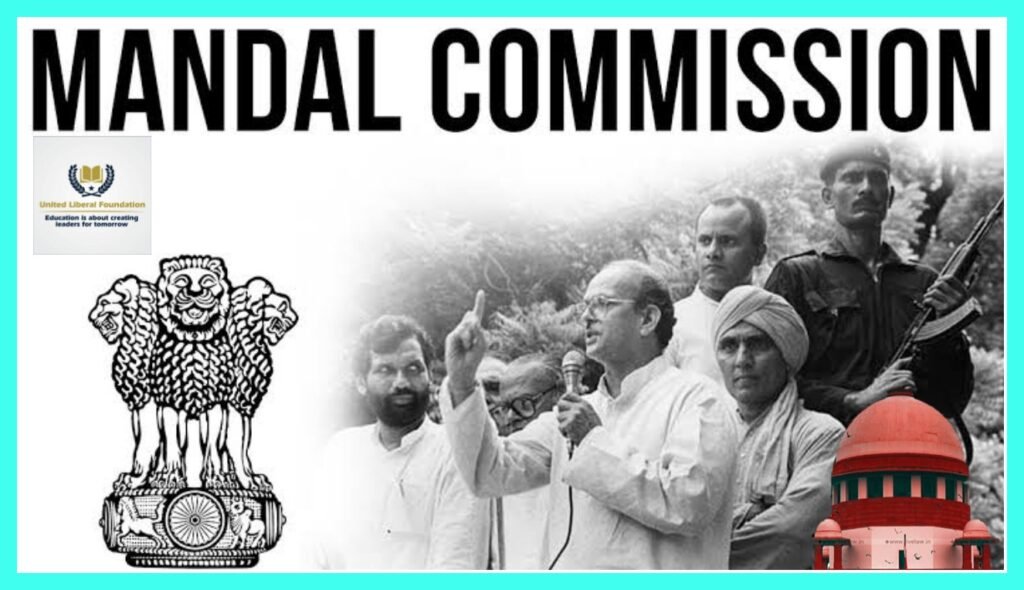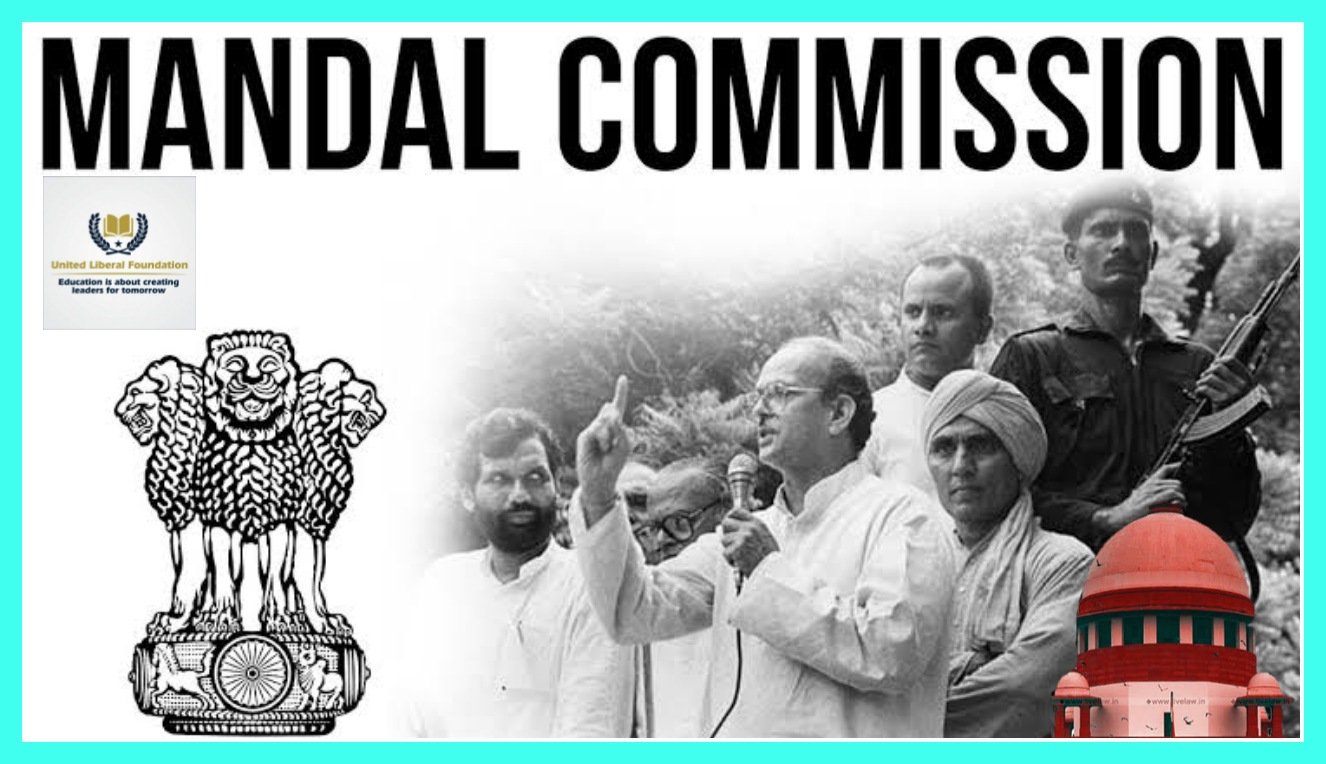
Introduction
परिचय
A Nine Judge Bench of the Supreme Court has laid down in Indra Sawhney ‘s Case ( Popularly known as Mandal Commission Case ) regarding reservation in Government employment that :
सर्वोच्च न्यायालय की नौ न्यायाधीशों की पीठ ने सरकारी नौकरी में आरक्षण के संबंध में इंद्रा साहनी के मामले (जिसे मंडल आयोग मामले के नाम से जाना जाता है) में निर्धारित किया है कि:
Key Points
प्रमुख बिंदु
◆ The Mandal Commission, officially known as the Socially and Educationally Backward Classes Commission (SEBC), was set up on 1st January 1979 by the Indian Government under the then Prime Minister Morarji Desai. The Commission was chaired by an Bindeshwari Prasad Mandal .
मंडल आयोग, जिसे आधिकारिक तौर पर सामाजिक और शैक्षिक रूप से पिछड़ा वर्ग आयोग (SEBC) के रूप में जाना जाता है, इसकी स्थापना 1 जनवरी 1979 को तत्कालीन प्रधानमंत्री मोरारजी देसाई के अधीन भारत सरकार द्वारा की गई थी। आयोग की अध्यक्षता एक बिंदेश्वरी प्रसाद मंडल ने की थी।
◆ The chief mandate of the Mandal Commission was to identify the socially or educationally backward classes of India and to consider reservations as a means to address caste inequality and discrimination. The Commission submitted its report to the President on 31st December 1980.
मंडल आयोग का मुख्य उद्देश्य भारत के सामाजिक या शैक्षणिक रूप से पिछड़े वर्गों की पहचान करना और आरक्षण को जातिगत असमानता और भेदभाव को दूर करने के साधन के रूप में मानना था। आयोग ने 31 दिसंबर 1980 को अपनी रिपोर्ट राष्ट्रपति को सौंपी।
◆ Under Article 16(4) provisions can be made in favour of the backward classes in the matter of employment by Executive orders also.
अनुच्छेद 16(4) के अंतर्गत कार्यपालक आदेश द्वारा भी रोजगार के मामले में पिछड़े वर्गों के पक्ष में प्रावधान किये जा सकते हैं।
◆ Backwards Class of citizens is not defined in the Constitution. A caste may also constitute a class.
नागरिकों के पिछड़े वर्ग को संविधान में परिभाषित नहीं किया गया है। एक जाति भी एक वर्ग का गठन कर सकती है।
◆ The backwardness contemplated by Article 16(4) is mainly social . It need not be both social and educational.
अनुच्छेद 16(4) में वर्णित पिछड़ापन मुख्यतः सामाजिक है। यह सामाजिक और शैक्षिक दोनों नहीं होना चाहिए।
◆ Income or the extent of property can be taken as a measure of social advancement and on that basis the ‘ creamy layer ‘ of a given caste can be excluded.
आय या संपत्ति की सीमा को सामाजिक उन्नति के उपाय के रूप में लिया जा सकता है और उस आधार पर किसी जाति के ‘क्रीमी लेयर’ को बाहर रखा जा सकता है।
◆ The reservations contemplated in Article 16(4) is confined to initial appointment only and cannot extend to providing reservations in promotion.
अनुच्छेद 16(4) में उल्लिखित आरक्षण केवल प्रारंभिक नियुक्ति तक ही सीमित है और पदोन्नति में आरक्षण प्रदान करने तक सीमित नहीं है।
◆ The commission developed 11 criteria to identify the backward classes who were called “Other Backward Classes” or OBCs. The criteria are classified as social, economic and educational.
आयोग ने पिछड़े वर्गों की पहचान करने के लिए 11 मानदंड विकसित किए जिन्हें “अन्य पिछड़ा वर्ग” या ओबीसी कहा जाता था। मानदंडों को सामाजिक, आर्थिक और शैक्षिक के रूप में वर्गीकृत किया गया है।
Social Indicators
सामाजिक संकेतक
◆ Castes or classes considered socially backward by others.
जातियाँ या वर्ग दूसरों द्वारा सामाजिक रूप से पिछड़े माने जाते हैं।
◆ Castes or classes that relied on manual labour for their livelihood.
जातियाँ या वर्ग जो अपनी आजीविका के लिए शारीरिक श्रम पर निर्भर थे।
Educational Indicators
शैक्षिक संकेतक
◆ Castes or classes where the number of children between the ages of 5 and 15 who never attended school is at least 25% more than the state average.
ऐसी जातियाँ या वर्ग जहाँ 5 से 15 वर्ष के बीच के ऐसे बच्चों की संख्या जो कभी स्कूल नहीं गए, राज्य के औसत से कम से कम 25% अधिक है।
◆ Castes or classes when the rate of student dropout between the ages of 5 and 15 is at least 25% more than the state average.
जातियाँ या वर्ग जब 5 से 15 वर्ष की आयु के बीच छात्र छोड़ने की दर राज्य के औसत से कम से कम 25% अधिक हो।
◆ Castes or classes amongst whom the proportion of matriculates is at least 25% less than the state average.
जातियाँ या वर्ग जिनमें मैट्रिक पास का अनुपात राज्य के औसत से कम से कम 25% कम है।
Economic Indicators
आर्थिक संकेतक
◆ Castes or classes where the average value of family assets is at least 25% less than the state average.
जातियाँ या वर्ग जहाँ पारिवारिक संपत्ति का औसत मूल्य राज्य के औसत से कम से कम 25% कम हो।
◆ Castes or classes where the number of families living in kutcha houses is at least 25% more than the state average.
जातियाँ या वर्ग जहाँ कच्चे घरों में रहने वाले परिवारों की संख्या राज्य के औसत से कम से कम 25% अधिक है।
◆ Castes or classes where the number of households having taken consumption loans is at least 25% more than the state average.
जातियाँ या वर्ग जहाँ उपभोग ऋण लेने वाले परिवारों की संख्या राज्य के औसत से कम से कम 25% अधिक है।
◆ At least 10% males and 25% females more than the state average got married below the age of 17 years in rural areas.
राज्य के औसत से कम से कम 10% पुरुषों और 25% महिलाओं की शादी ग्रामीण क्षेत्रों में 17 साल से कम उम्र में हुई।
◆ At least 5% males and 10% of females more than the state average got married below the age of 17 years in urban areas.
शहरी क्षेत्रों में राज्य के औसत से कम से कम 5% पुरुषों और 10% महिलाओं की शादी 17 साल से कम उम्र में हुई
◆ Castes/classes where participation of women in work is at least 25% more than the state average.
जातियाँ/वर्ग जहाँ कार्य में महिलाओं की भागीदारी राज्य के औसत से कम से कम 25% अधिक हो।
Conclusion
निष्कर्ष
◆ Implementation of Mandal commission recommendations empowered communities. But the current architecture of reservations needs a review, with the aim of creating a just, inclusive and equal society,
मंडल आयोग की सिफारिशों को लागू करने से समुदायों को अधिकार मिला। लेकिन एक न्यायपूर्ण, समावेशी और समान समाज बनाने के उद्देश्य से आरक्षण की वर्तमान संरचना की समीक्षा की आवश्यकता है।
ULF Mains Questions for Answer Writing Practice
Q.1 The policy of reservation is the best way to achieve social justice in Indian society”. Critically discuss.(250 Words)
आरक्षण की नीति भारतीय समाज में सामाजिक न्याय प्राप्त करने का सबसे अच्छा तरीका है।” आलोचनात्मक चर्चा करें। (250 शब्द)
Team ULF




